List of works by Alexandre Falguière
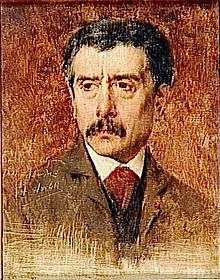
This is a list of some of the works by the French artist Alexandre Falguière.
Biography
Falguière was born in Toulouse on 7 September 1831 into a modest home, his father working as a mason. His father did however manage to put him into the Toulouse École des Beaux-Arts where he studied both painting and sculpture and in 1853 was awarded the Toulouse municipal prize for sculpture, which allowed him to study at the Beaux-Arts in Paris, with Toulouse making a contribution towards payment of his fees and expenses. Once he arrived in Paris he worked in the studio of Albert-Ernest Carrier-Belleuse so that he could earn some extra cash to supplement the Toulouse funds and then moved to Jean-Louis Chenillon's studio. In 1854 he finally entered the École des Beaux-Arts and there won the Prix de Rome in 1859. He was then 23 years of age, so very near the Prix de Rome age limit. Winning this prestigious prize not only gave him a welcome bursary and access to further funds, but allowed him to travel to and study in Rome and whilst there he executed several pieces. The first piece he sent back to France was a bas-relief entitled "Des Joueurs de cerceau" and then "Thésée enfant", a work in marble and his first work accepted by the Salon. He also completed in Rome the work "Omphale" worked in marble, and "Nuccia la trastecerina." both of which made the Salon, the latter being purchased by the State. It was however his 1864 submission to the Salon called "le Vainqueur au combat de coqs" which was to make his reputation. When he returned to Paris from Rome in 1867, his work was already well known and highly regarded and he sealed this with his Salon submission "Tracisius". Now from his small studio in the rue de l'Ouest, later called the rue d'Assas, he produced work after work. In 1868 he was awarded the Medal of Honour at the Paris Salon and was appointed Officer of the Légion of Honor in 1878, in 1889 becoming a "commandeur" of that order. He had been made a member of the Académie française in 1882 and in the same year was made professor at the École des Beaux-arts. In 1870, with Paris under siege by the Prussian army, Alexandre Falguière enrolled in the National Guard and it was at this time that he made a sculpture from snow called "La Résistance" a work celebrated by the poets Théodore de Banville and Théophile Gautier, both fellow members of the guard. The 1880s saw a huge demand for statues, France being gripped by "statuomanie" and Falguière was swamped by commissions. By the end of his life Falguière was running five studios and had many pupils including Idrac, Injalbert, Marqueste, Théodore-Rivière and Antonin Mercié. His output was prolific, many of his compositions being repeated in various materials and sizes. Many of his original plaster works were cast in bronze or sculpted in marble so that the same work can be seen in various locations, albeit in different materials and of different dimensions and many of his maquettes are preserved in museums. Falguière was undoubtedly one of the finest French sculptors to practice at the time of the Second Empire.[1]
From 8 February to 8 March 1902, a major exhibition of Falguière's work was held at the École National des Beaux-Arts in Paris and Falguière's widow asked G Larroumet, a long time friend of Falguière and permanent secretary of the École, to write a preface in the exhibition catalogue. We are fortunate that this can be read on-line and some of the information in the catalogue is used in this article.[2][3]
Early works
| Name | Location | Photograph | Date | Notes |
|---|---|---|---|---|
| Thésée enfant | Musée des Augustins in Toulouse | 1857 | Falguière made his debut at the Paris Salon with this composition entitled "Thésée enfant", a statuette in plaster.[4][5] | |
| Mézence blessé, préservé par l'intrépidité de son fils Lausus | École nationale supérieure des Beaux-Arts in Paris | 1859 | It was with this plaster bas-relief that Falguière won the Prix de Rome in 1859.[6]
Falguière then travelled to Rome and at the villa Médicis there became a friend of fellow French sculptor Jean-Baptiste Carpeaux. He spent time in Tuscany and there discovered the works of the Florentine renaissance and became so inspired that together with fellow sculptors Paul Dubois and Henri Chapu he formed the group which called itself the "Néo-Florentins"[7] | |
| Joueurs de cerceau | Whereabouts not known. | 1860 | An early work by Falguière[5][7] | |
| Le Vainqueur au Combat de Coqs | Musée des Augustins in Toulouse | 1864 | This work was completed in 1864 and was Falguière's first bronze statue of importance. A photograph of this work is shown in the gallery below. The plaster model was completed in 1863 and the bronze version was exhibited at the Salon des Artistes français in 1864 and received a medal. Victor Thiébaut carried out the casting. From 1883 to 1884, the statue stood in the garden of the Grand-Rond but was subsequently taken into the Musée des Augustins and a copy kept in the museum's garden. "Le Vainqueur au Combat de Coqs" was inspired by Jean de Bologne's "Le Mercure".[8] | |
| Tarcisius, martyr crétian | Musée d'Orsay | 1867 | This work was Falguière's submission to the Paris Salon in 1868. Together with "Le Vainqueur au Combat de Coqs" it was also exhibited in the Luxembourg Museum. Both "Le Vainqueur au Combat de Coqs" and "Tarcisius, martyr crétian" are now in the Musée d'Orsay.[5][7] | |
| À la porte de l'école | Musée des Augustins in Toulouse | 1887 | This work in plaster, shown at the Paris Salon of 1887, was unusual in that Falguière moved away from his usual depictions of nymphes, gods and goddesses and famous people and here depicted an ordinary woman with her two children at the entrance to a local school. The mother carries a small baby who she shows to her young daughter who embraces the baby before going into school. A charming study.[9] | |
Works located in Paris
| Name | Location | Photograph | Date | Notes |
|---|---|---|---|---|
| Pégase emportant le poète vers les régions du rêve | Square Louis Jouvet in Paris | This work by Falguière stands in Paris' Square Louis Jouvet[10] | ||
| Statue of Archimedes | Paris | In the main entrance hall of the Sorbonne in Paris and looking out on to Rue des Écoles are two statues representing the Arts and the Sciences. These are "Homer" by E. Delaplanche and "Archimedes" by Falguière.[11] | ||
| Statue of Honoré de Balzac | Paris | 1899 | This statue can be seen in the avenue Friedland in Paris. This piece was submitted to the Paris Salon in 1899 and the maquette is held in the Maison de Balzac. | |
| Statue of Pierre Corneille and other Falguière works in Paris' Comédie Française | Paris | 1878 | Alexandre Falguière submitted a study of this great French dramatist to the 1878 Salon, indicating that the marble work was destined for the Comédie Française and in " Albums des salons du XIXe siècle ; salon de 1883" which detailed various works purchased by the French State, the Corneiile work was included- "Pierre Corneille", statue, marbre (Salon de 1878) par Alexandre Falguière, No 981, pour la Comédie Française, l'oeuvre mesure H. 1, 55 x L. 0, 80 x P. 1, 10 m". The Corneille work is now held in the Comédie Française's collection which includes other works by Falguière. These works were all catalogued by the Bibliothèque-Musée and as a tribute to La Grange who was a comedian and longtime companion of Molière and had compiled a register of the life and activities of the 1659 Molière group of actors, the collection's exhaustive catalogue was named after him.[12]
The Falguière works held by the Comédie Française are-
| |
| Asie | Paris | 1878 | For the Éxposition Universelle in Paris in 1878, a series of six statues were commissioned, each depicting one of the continents. Falguière was asked to tackle Asia and his composition is now in the forecourt of the Musée d'Orsay. A photograph of this statue can be seen in the "Gallery" below. The other five works were Alexandre Schoenewerk's "L'Europe", Eugène Delaplanche's "L'Afrique", Ernest-Eugène Hiolle's "L'Amérique du Nord", Aimé Millet's "L'Amérique du Sud" and Mathurin Moreau's "L'Océanie".[15] | |
| Monument to Ambroise Thomas | Paris' Parc Monceau | 1902 | This Falguière work is in Paris' Parc Monceau. Thomas, a French composer, is shown sitting in meditative mood, whilst Mignon one of his heroines offers him flowers. Ambroise Thomas led the Conservatoire de musique de Paris.[16][17] | |
| Monument Georges Bizet at Opéra Comique in Paris | Paris | Opéra Comique's "Salle Bizet" contains Falguière's monument to Bizet. In Falguière's composition Bizet is embraced by an allegory of music whilst a depiction of Carmen sits at his feet.[18]
Bizet had been a close friend of Falguière who loved music and loved to sing. He had a fine tenor voice | ||
| Equestrian group in the Palais de la Découverte in Paris | Paris | This Falguière composition was cast in bronze in 1900 by the foundry Salin. The work is entitled "L'inspiration guidée par la sagesse". It is located in the Palais de la Découverte at the rear of the Grand Palais. The Palais de la Découverte is also known as the Palais d'Antin.[19] | ||
| "Triomphe de la Révolution" | Musée d'Orsay | The Musée d'Orsay hold the maquette for Falguière's "Triomphe de la Révolution", an elaborate quadriga which depicts a chariot drawn by horses preparing to "crush Anarchy and Despotism". A large plaster version was placed on the top of the Arc de Triomphe from 1882 to 1886 until it crumbled. Sadly a version in bronze, which could have endured exposure to the elements, was never commissioned. Only the maquette therefore survives for us to see this remarkable work.[20] | ||
| Sculpture entitled "Le Drame" | Paris | 1860 to 1869 | This composition is one of the many sculptures which adorn the Palais Garnier/ Opéra National de Paris.[5][21] | |
| Monument to Louis Pasteur | Paris | Situated in Paris, in the Place de Breteuil, this large and elaborate monument pays tribute to Louis Pasteur, France's great chemist and microbiologist. It was Falguière's final work, being completed in 1900. Pasteur is depicted seated and wearing a dressing gown and surrounded by various sculptural groupings which underline his achievements. Falguière includes the figure of Death himself and near to a mother and her child but, thanks to Pasteur, death is no longer so powerful and less likely to harm them. Elsewhere we see a young woman convalescing and cattle and sheep, the latter with a shepherd. All recall Pasteur's vaccines against rabies and cholera and his studies into the illnesses linked to the silkworm. In the gallery below we can see some of Falguière's sculptures which form part of the monument. The sculptor Victor Peter helped to finish this quite remarkable monument.[22] | ||
Falguière's works in Paris' Musée d'Orsay
There are many Falguiere works in Paris' Musée d'Orsay.[23] These include:
- Eve
This composition depicting Eve and a serpent was completed around 1880. The museum hold a plaster version. A large version in marble was shown at the Paris Salon of 1880 and this is now held in Copenhagen's Ny Carlsberg Glyptotek.[24]
- Baronne Daumesnil
This marble bust dates to 1879. The Musée d'Orsay also hold the plaster model and a version in terracotta can be seen in the Musée of Périgord, Périgueux, and a bronze version is held by Bayonne's Musée Bonnat. The work has two inscriptions: "DONNE A LA FRANCE PAR SA PETITE FILLE / LA VICOMTESSE THERESE DE CLAIRVAL NEE MORIZOT" and "ANNE FORTUNEE LEONIE GARAT BARONNE DAUMESNIL / SURINTENDANTE DE LA LEGION D'HONNEUR". Until 1891 the work was held in the collection of the Vicomtesse Thérèse de Clairval, née Morizot and was then presented as a gift to the French nation. From 1891 to 1916 it was held by the Musée du Luxembourg in Paris, and from 1916 to 1956 was held by the Musée du Louvre, Paris. In 1986 it was taken into the Musée d'Orsay.[25]
- La danseuse
A marble version was shown at the Salon in 1896 and at the 1902 Falguière retrospective[26]
- Bust of Léon Gambetta
Thought to date to around 1895, this bronze bust of Léon Gambetta was cast by Thiébaut. The Musée d'Orsay also hold the version in terracotta dating to 1882. Other terracotta versions are to be found in the Musée Granet in Aix-en-Provence and the Musée Carnavalet in Paris and another Thiébaut bronze is to be seen in the Musée de Picardie in Amiens. There is a bronze cast by Bingen in the Indiana University museum, Bloomington and Sèvres brought out a biscuit version. A marble version is in the Palais du Sénat in Paris and there are of course the full scale monuments to Gambetta in Cahors and Saïgon.[27]
- Bust of woman entitled "Pompadour"
A wax version of this Falguière piece can be seen in the Petit Palais in Paris held under the title "Mme X dans le goût du XVIIIe", and Sèvres sold a biscuit version from 1907 to 1941 under the name "La Pompadour".[28]
- Triomphe de la Revolution
The Musée d'Orsay hold the maquette for Falguiere's "Triomphe de la Revolution". It depicts a chariot drawn by horses preparing "to crush Anarchy and Despotism". A large plaster version was placed on the top of the Arc de Triomphe from 1882 to 1886 until it crumbled and a version in bronze which could have endured the elements was never commissioned.[29]
- Pégase emportant le poète vers les régions du rêve
Falguière executed this work depicting Apollon riding on Pégase between 1880 and 1897 and the Musée d'Orsay hold the plaster model. The model was made for a secret competition in 1880 for designs for the proposed monument to Victor Hugo in Paris, a commission which went to Barrias. A bronze of this sculpture was submitted to the Salon in 1897 and that bronze is now located in the Square de l'Opéra-Louis-Jouvet. A smaller version of the work, 71 centimetres high, was cast in bronze by Thiébaut frères, Fumière et Gavignot.[30]
- Vainqueur à la course
The Musée d'0rsay have an 1870 version of this Falguière composition and there is a bronze version in the Jardin des Tuileries in Paris. The work was purchased from the Salon by the State in 1870 and in 1871 was exhibited at the Musée du Luxembourg. After being held in various locations it was finally taken into the Musée d'Orsay in 1986.
- Saint Vincent de Paul
This work in marble is thought to date to 1879 when it was shown at the Salon de la Société des artistes français. It was then shown at the Paris Exposition of 1883. The foundry Thiébaut cast a bronze version and another of just the bust. On the pedestal of this marble work the inscription reads: :St VINCENT DE PAUL/1591-1660/APOTRE DE LA CHARITÉ/CURÉ DE CLICHY/1612-1625" The sculpture was held from 1879 to 1944 in the Panthéon in Paris, then by the Église de Saint-Médard in Clichy until 1986 when it was passed to the Musée d'Orsay.[31]
- Tarcisius, martyr chrétien
The Musée d'Orsay hold an 1868 marble version of this work. The plaster model was purchased by the State from the Salon of 1867 and shown at the "l'Exposition Universelle" from 1867 to 1900. It is held by the Musée des Augustins in Toulouse,. A mask of Tarcisius is held by the Petit Palais in Paris and other plaster versions are held by Ny Carlsberg Glyptotek in Copenagen as well as in Toulouse. There is a bronze version at the Detroit Institute of Arts.[32]
Gallery of images of Pasteur monument
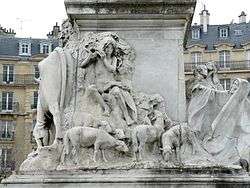 Part of Falguière's Louis Pasteur monument. A shepherd guards his flock of sheep.
Part of Falguière's Louis Pasteur monument. A shepherd guards his flock of sheep. Part of Falguière's Louis Pasteur monument. A boy herds his cattle.
Part of Falguière's Louis Pasteur monument. A boy herds his cattle.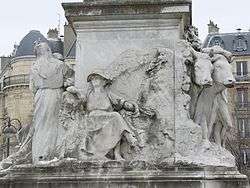 Part of Falguière's Louis Pasteur monument.
Part of Falguière's Louis Pasteur monument. Part of Falguière's Louis Pasteur monument.
Part of Falguière's Louis Pasteur monument.
Works outside of Paris
| Name | Location | Photograph | Date | Notes |
|---|---|---|---|---|
| Monument to Admiral Amédée Courbet | Abbeville | Falguière worked with Antonin Mercié on this extravagant baroque statue. The statue was damaged in a bombing raid during the 1914–1918 war and was not restored. It is located in Abbeville's Place de l'Amiral Courbet. To demonstrate the amount of damage which the monument sustained, the links below offer the opportunity to see the monument in its undamaged form (a Getty image) and as it is today. A link is also given to a report written at the time of the Abbeville bombing.[33][34]
A medal was struck celebrating the monument.[35][36] Courbet was a French admiral who won a series of important land and naval victories during the Tonkin campaign (1883–86) and the Sino-French War (August 1884 – April 1885). He had been born in Abbeville. | ||
| Monument to Cardinal Lavigerie | Bayonne | This Falguière monument is in Bayonne, Lavigerie's birthplace. Lavigerie was a French cardinal, Archbishop of Carthage and Algiers, Primate of Africa and a significant figure in France's anti-slavery movement.[37] | ||
| Statue of Pierre de Fermat | Beaumont-de-Lomagne | It was the mathematician Despeyrous, a citizen of Beaumont, who in 1881 offered a bronze statue of fellow mathematician Pierre de Fermat, by Falguière to the town of his birth. In 1943 the statue was taken and melted down for use in the manufacture of munitions. In 1954 the people of Beaumont and its mayor organized a replacement but in stone rather than bronze.[38][39] | ||
| Monument to Léon Gambetta. | Cahors | The monument to Gambetta in Cahors had originally been an elaborate composition by Falguière but now comprises a statue of Gambetta on a pedestal. Originally there had been bronzes of a crouching marine in attacking mode, a draped flag and a wounded infantryman but these were taken in 1943 and melted down for the manufacture of armaments. The monument is in the centre of Cahors, in the Square François Mitterrand, close to the Allées Fenelon and the pedestal bears the simple inscription "à / [Léon] Gambetta / né à Cahors / le 2 avril 1838" Gambetta had died following an accident in 1882 and the monument was erected soon afterwards, being inaugurated on 14 April 1884 in the presence of Jules Ferry and Pierre Waldeck-Rousseau. In Falguière's composition, Gambetta's right arm rests on a cannon, presumably representing the French Revolutionary tradition of a "nation at arms" and recalling Gambetta's rôle in resisting Prussian military occupation after the Franco-Prussian War. His right arm is raised, as if he was in full, rhetorical flow, exhorting his Republican followers and the French nation more generally to take action. Indeed part of one of his rousing speeches is chiseled onto the plinth of the statue. "Francais / Elevez vos âmes et vos résolutions à la / hauteur des effroyables périls qui / fondent sur la patrie / il dépend encore de nous de lasser [sic] la / mauvaise fortune et de montrer à l'univers / ce qu'est un grand peuple qui ne veut / pas périr et dont le courage s'exalte au / sein même des catastrophes" The monument area was designed by architect Paul Pujol and the statue was cast in the foundry of the Thiébaut brothers.[40][41] | ||
| Death mask of Gambetta | Cahors | 1882 | The Musée de Cahors Henri Martin in Cahors have a death mask of Gambetta by Falguière.[42] | |
| Statue of Armand Barbès | Carcassone | 1886 | Falguière executed a statue of Armand Barbès in Carcassone in 1886 but this no longer exists and was replaced by a statue by Claude Marquié. Barbès was a French revolutionary and opponent of the July monarchy (1830–1848).[43] | |
| La Sasson | Chambéry | La Sasson |
1892 | The monument in Chambéry in Savoie was erected in 1892 and inaugurated by Sadi Carnot the French president, as part of the celebrations celebrating the centenary of Savoie's absorption into France at the time of the French revolution. A Sasson is a native of Savoie.[44] The Germans removed the statue in 1942 during the occupation but it was fully restored in 1982. The inscription reads " LA SASSON. STATUE DE LA SAVOIE COMMEMORANT LE CENTENAIRE DE L'ANNEXION DE LA SAVOIE A LA FRANCE 1792–1892. DEPOSEE SOUS L'OCCUPATION EN 1942 PUIS RETROUVEE / EN ALLEMAGNE ELLE FUT RESTAUREE ET REINSTALLEE / EN 1982. OEUVRE D'ALEXANDRE FALGUIERE" |
| Monument à Jules Grévy | Dôle | Falguiere's bronze statue of Jules Grévy was erected in 1893 and stood in the place Jules-Grévy but was removed in 1942 by the Vichy regime and the bronze melted down for the manufacture of armaments.[47] Jules Grévy was a President of the French Third Republic and one of the leaders of the Opportunist Republicans faction. Given that his predecessors were monarchists who tried without success to restore the French monarchy, Grévy is seen as the first real republican President of France. | ||
| Évian-les-Bains. The villa "La Sapinière" | Évian-les-Bains | Jonas Vitta, a wealthy banker, commissioned the architect Jean Camille Formigé in 1892 to design this villa at Lake Léman near Evian-les-Bains. Jonas died in that year but his son, Baron Joseph,continued the villa's decoration, and commissioned work from sculptors Rodin, Georges Guardet, Falguière and Alexandre Charpentier and painters and engravers Paul-Albert Besnard, Félix Bracquemond and Jules Chéret. In the gallery below are photographs of some of Falguière's bas-reliefs which decorate the villa.[48] | ||
| La Nymphe | Laon | The work "La Nymphe" was always called "Diane chasseresse" by Falguière and this bronze version is located along the Rampe d'Ardon in Laon in the Aisne. The Rampe d'Ardon is the winding road which takes one to the summit of the hill on which Laon sits. Cast in bronze by Thiébaut frères in 1882, it was given to Laon by the State in exchange for a painting by Vouet in 1885–1886. This is a good example of how a work by Falguière can appear in various locations, as apart from the Laon bronze the work also appears in Nogent- sur-Seine's Musée Paul Dubois-Alfred Boucher and the plaster version is held by the Musée des Beaux-Arts in Toulouse.[49] | ||
| Monument to Lamartine | Macon | Monument to Lamartine in Macon |
Lamartine, the French poet, full name Alphonse Marie Louis de Prat de Lamartine, was born in Macon and Falguière's statue was erected in front of the Macon Hôtel de Ville in 1878. Students of the writer, poet and politician believe he was instrumental in the foundation of the Second Republic[50] | |
| Monument to Louis-Toussaint Dassy | Marseille | 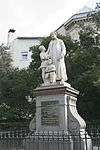 Monument to Louis-Toussaint Dassy |
Y | Louis-Toussaint Dassy was a missionary priest and historian who in his lifetime did much to help blind children. This monument was designed by Pujol and Falguière carried out the sculptural work involved. The monument is situated in the Jardin de la colline Pierre Puget in Marseille and the composition includes a young blind girl.[51][52] |
| Bust of Jacques Mathieu Delpech | Montpellier | 1860 | This bust is located in the University of Montpellier's Medical Faculty. Delpech was a surgeon both in Toulouse and Paris before becoming Professor of Clinical Surgery at Montpellier. He was assassinated by one of his patients.[53] | |
| sculpture of Augustin Calmet | Munster | .jpg) The tomb of Augustin Calmet |
Calmet was born and died in Senones but had many associations with Munster and the above work marks his tomb in the Abbaye de Senones. A plaster version can be seen in Munster's town hall.[54] | |
| Monument du Président Sadi Carnot | Nolay | This monument in Nolay in the Côte-d'Or dates to 1895. The monument was first conceived by the sculptor Jules Roulleau but finished by Falguière. Marie François Sadi Carnot was a French statesman and the fourth president of the Third French Republic. He served as the President of France from 1887 until his assassination in 1894.[55] The firm of Gandinot and Verdie of Charleville carried out the casting of the figure of Sadi Carnot and the monument's inauguration took place on 8 September 1895. The statue was destroyed during the Vichy regime and the bronze melted down.[56][57] | ||
| Monument to Emmanuel d'Alzon | Nîmes | 1893 | Emmanuel D'Alzon (1810–1880) was a leading French cleric in the 19th century and Falguière's 1893 bronze sculpture shows Father d'Alzon on his knees and in prayer. It stands in the Collège d'Assumption in Nîmes. D'Alzon had founded the "Augustins de l'Assomption". The statue was erected on 28 June 1893 to celebrate the 50th anniversary of the Collège d'Assumption's foundation.[58] | |
| Statue of Alphonse Daudet | Nîmes | 1900 | This statue is in the Square de la Couronne in Nîmes. Daudet was a French novelist.[59] | |
| Monument to Jean Baptiste de La Salle | Rouen | The Jean Baptiste de La Salle monument in Rouen. Here we see two of the four children spaced about the monument's base. |
1875 | This monument and fountain in Rouen was built in the 1800s to celebrate Jean Baptiste de La Salle's enormous contributions to education.[60]
The statue was first erected in 1875 in the Place Carnot but was transferred to the quieter neighborhood of St. Sever because of the difficulties with traffic circulation in 1885. The bronze shows De La Salle teaching a young child whilst a second pupil is deeply engrossed in reading a book. Further sculptures of children are placed at the four corners of the monument representing the four corners of the earth. Falguière's bas-reliefs recall de La Salle's generosity in giving his possessions to the poor and that he was honored with a visit from James II at his boarding school in Paris.[61][62] |
| Fountain | Rouen | In 1874 a retaining wall cum fountain was constructed in Rouen's rue Louis-Ricard / rue Sainte-Marie. Edward de Perthes was the designing architect and Falguière was commissioned to carry out some sculptural decoration for this fountain. The underground reservoir was an important part of the work carried out between 1870 and 1874 to improve Rouen's water supply and after the construction of the reservoir was completed, a competition was held for the design and installation of a fountain which de Perthes and Falguière completed between 1874 and 1879. The fountain served as a retaining wall holding back the water in the reservoir. Falguière's work on the fountain included three groups of sculpture, with allegories of "L'Élevage", "the City of Rouen" and "Agriculture".[63][64] | ||
| Statue of Henri de La Rochejaquelein | Saint-Aubin-de-Baubigné | 1895 | This Falguière work is located in Saint-Aubin-de-Baubigné. It was erected in honour of the counter-revolutionary Henri de La Rochejaquelein. He had lost his life at Nuaillé, near Cholet on 28 January 1794 at the age of 22. On the pedestal supporting his statue are engraved his celebrated words spoken at the Château de la Durbelière before 2000 soldiers.
" Si j'avance, suivez-moi, si je recule tuez-moi, si je meurs vengez-moi" This translates as "If I advance, follow me, if I retreat kill me, if I die revenge me" | |
| Monument to Pèire Godolin | Toulouse | 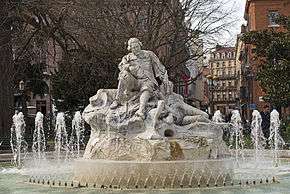 Monument to Godolin in Toulouse |
This monument is located in the Place Wilson in Toulouse. Pierre Godolin, sometimes referred to as Pierre Goudouli, or Pierre Goudelin, was born in 1580 in Toulouse where he died on 10 September 1649. He was an Occitan poet and often wrote in the Toulouse dialect. His best known work was "The Ramelet Moundi". In Falguière's composition, Godolin sits on a rock with his left hand resting on a book. His hat lies at his feet as well as a nude woman who holds a jar from which the fountain's water flows. This figure is thought to be an allegory for the river Garonne.[65][66] | |
| Statue of David d'Angers | Angers | 1878 | The Musée des beaux-arts in Angers holds the original model submitted by Falguière for the competition held to select the sculptor of a tribute to David d'Angers.[67][68] | |
Images of villa "La Sapinière"
 Falguière bas-relief at the Villa La Sapinère.
Falguière bas-relief at the Villa La Sapinère.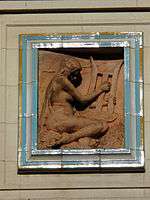 Falguière bas-relief at the Villa La Sapinère
Falguière bas-relief at the Villa La Sapinère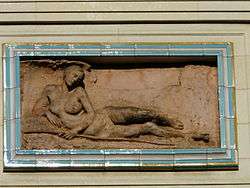 Falguière bas-relief at the Villa La Sapinère
Falguière bas-relief at the Villa La Sapinère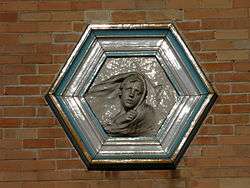 Falguière bas-relief at the Villa La Sapinère
Falguière bas-relief at the Villa La Sapinère
Works in churches
| Name | Location | Photograph | Date | Notes |
|---|---|---|---|---|
| Vierge à l'Enfant | Clairefontaine-en-Yvelines | In the parish church of Saint-Nicolas in Clairefontaine-en-Yvelines is a Falguière terracotta statue of the Virgin Mary with Baby Jesus. Originally the work was intended for Marseille's cathedral but was never installed there and was finally given to the parish church by Falguière's wife after his death. One of the inscriptions on the pedestal reads:
"PROJET DE STATUE POUR LA CATHEDRALE DE MARSEILLE D'ALEXANDRE FALGUIERE STATUAIRE MEMBRE DE L'INSTITUT COMMANDEUR DE LA LEGION" | ||
| Tomb of Mgr Charles Emile Freppel | Angers Cathedral | 1891 | Falguière executed the sculpture for the tomb of Mgr Charles Emile Freppel in Angers Cathedral. The work is in white marble, was executed in 1891, and the inauguration took place on 13 November 1899.[71][72] | |
| Église de Saint-François-Xavier. | Paris | Falguière's work can be seen in the Église de Saint-François-Xavier in Paris. On the columns which decorate the arch of the sanctuary, Falguière has carved an angel with grapes and another with a sheaf of wheat, both symbols of the Eucharist.[73][74] | ||
| Statue de Sainte Anne | Basilica of Auray | The statue of St Anne in Auray in Morbihan is now located in the Basilica's garden. It depicts St Anne teaching the Virgin Mary to read and is carved from Kersanton granite. The statue weighs 12 ton and had originally been gilded and positioned at the top of the Basilica. Damaged in 1939, its weight required it to be moved and it was moved to its present location. Falguière worked on the original statue as well as the sculptor Le Goff and the architect Deperthes.[75]
In the Basilica itself the master altar has carvings by Falguière of the four Evangelists dating to 1874.[76] | ||
| Statue of Sainte Germaine | Toulouse | 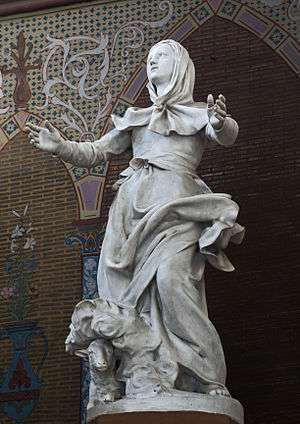 |
1887 | Falguière's statue of Saint Germaine is in the église Sainte Germaine in Toulouse.[77]
Inauguration took place on 29 July 1877. The statue was originally located in the place Saint-Georges before being moved into the church.[78] |
Public monuments outside France
| Name | Location | Photograph | Date | Notes |
|---|---|---|---|---|
| Greece crowning Lord Byron. | Athens | In a very central area of Athens, Greece, and outside the National Garden, is a statue depicting Greece in the form of a woman crowning Byron. The statue was sculpted by Henri-Michel Chapu and Alexandre Falguière. | ||
| Statue of Major General Marquis Gilbert de Lafayette | Lafayette Square, Washington, D.C. | Statue of Marquis de Lafayette |
Falguiere and Antonin Mercié executed this statue, which was installed in 1891 at Lafayette Square, Washington, D.C..[79] | |
| Statue of Mariscal Sucre | Santo Domingo square, Quito |  Statue of Mariscal Sucre |
1890 | This monument was inaugurated in 1892. Sucre was Simón Bolívar's best General, who triumphed over the Spanish troops in the Battle of Pichincha, 24 May 1822. He was named Marshal after the final triumph of the patriot troops over the Spanish colonial army in Ayacucho, Perú, on 9 December 1824. Sucre was born in Cumaná, Venezuela, on 3 February 1795.[80] |
| Falguière's tomb |  Falguière tomb |
Falguière died in Paris in 1900 and was interred there in the Père Lachaise Cemetery, where his tomb was enhanced by a sculpture by Laurent Marqueste.[81] | ||
Miscellaneous
| Name | Location | Photograph | Date | Notes |
|---|---|---|---|---|
| Monument à la Revolution-Liberte. Égalite. Fraternite | Paris | This was a work that Falguiere was never able to complete owing to his death but there is an model in plaster of the projected sculpture in the collection of the Musée d'Orsay which they acquired in 1950. Three figures are allegories for liberty, equality and fraternity. This would have formed part of a large work dedicated to the revolution which Falguiere was commissioned to complete by the French State.[82] | ||
| "La résistance | Psris | Mention has already been made of the work "La résistance" which Falguière sculpted in snow whilst serving in the National Guard during the Prussian siege of Paris in 1870. Falguière subsequently made a terracotta model for the Petit Palais in Paris. There is also a copy of the composition in green wax in the musee Carnavalet in Paris. The terracotta figure is now held by the Musée des Augustins in Toulouse. A bronze casting by Thiebaut Freres is held in the Los Angeles County Museum. Falguière's model was also used to decorate the tomb of Doctor Lucio y Lopez in Buenos Aires' "Cimetiere de la Recoleta".[83] | ||
| Médallion celebrating the life of Falguière | A médallion was struck to celebrate Falguière's work. It featured a relief of Falguière which had been created a few years earlier by Victor Peter. Peter had been the sculptor who added the finishing touches to the Louis Pasteur monument. The médallion is held in the collection of Rennes' musée des beaux-arts.[84] | |||
| Medallion depicting E. Gebhart | Falguiere completed this médallion celebrating the life of E. Gebhart. It can be seen in the museum of Nemours castle.[85] | |||
Falguière as painter
Falguière was a painter as well as a sculptor. His works "Wrestlers" of 1875 and "Fan and Dagger" of 1882 were shown in the Luxembourg. The "Wrestlers" is held by the Musée d'Orsay.[86]
Gallery of some paintings
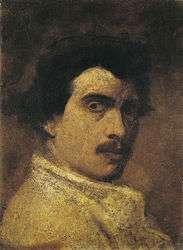 Self-portrait
Self-portrait Work entitled "Les Nains"
Work entitled "Les Nains"- The wrestlers.
Falguière as teacher
Amongst his many pupils were Francis Edwin Elwell, Julien Caussé, Laurent Marqueste, Henri Crenier and Théophile Barrau.
Works held by the Musée des Augustins in Toulouse
- "La Suisse accueille l'Armee francaise". 1874 Plaster work.[87]
- "La Resistance". 1870 Statuette in terracotta.[88]
- "La Musique". 1891 high-relief in plaster.[89]
- "La Musique".1889 Work in plaster.[90]
- "La Femme au paon". Work in marble. Dates to 1890.[91]
- "La Femme au paon". Work in plaster.[91]
- "Faune à la grappe". Work in plaster.[92]
- "Femme au phénix". Bas-relief in bronze.[93]
- "A la porte de l'école". Work dating to 1887. In plaster.[94]
- "Baigneuse". A Plaster statuette.[95]
- "Caïn et Abel". Work in terracotta.[96]
- "Diane". Head in terracotta.[97]
- "Diane". Head in terracotta.
- "Diane". Marble statue 70 centimetres high. This work was shown at the Salon in 1887.[98]
- "Jean Abadie". Marble bust.[99]
- "L'Automne". Marble statue.[100]
Gallery of works in Musée des Augustins
 La Femme au paon - Musée des Augustins
La Femme au paon - Musée des Augustins "DIane" in Musée des Augustins
"DIane" in Musée des Augustins Nymphe chasseresse
Nymphe chasseresse Henri de La Rochejaquelein.
Henri de La Rochejaquelein. Tarcisius martyr chrétien.
Tarcisius martyr chrétien. La Suisse accueille l'armée française
La Suisse accueille l'armée française
References
- ↑ . Introduction Falguière's work issued by the Augustin museum in Toulouse]. Retrieved 27 December 2013
- ↑ Exhibition catalogue. Retrieved 28 December 2013
- ↑ Exhibition catalogue for exhibition dedicated to Falguière. Held in Paris 8 February to 8 March 1902 at the École National des Beaux-Arts. Retrieved 27 December 2013
- ↑ "Thésée enfant" (PDF). musée des Augustins. Retrieved 28 December 2013.
- 1 2 3 4 "Joueurs de cerceau". Phidias – Encyclopédie des sculpteurs français. 2009–2012. Retrieved 9 February 2014.
- ↑ "Mézence blessé préservé par l'intrépidité de son fils Lausos". Joconde listing. Retrieved 21 December 2013.
- 1 2 3 "Text book by Benedite". Open library text biography. Retrieved 16 February 2014.
- ↑ "Le Vainqueur au Combat de Coqs". Patrimoine. Retrieved 23 December 2013.
- ↑ "À la porte de l'école" (PDF). Musee augustins. Retrieved 27 December 2013.
- ↑ "Pégase emportant". le poète vers les régions du rêve. L'Art Nouveau. Retrieved 2 January 2014.
- ↑ "Archimedes". Sorbonne. Retrieved 1 January 2014.
- ↑ "La Grange Catalogue". Culture. Retrieved 24 December 2013.
- ↑ "Comédie-Française". comedie francaise. Retrieved 26 January 2014.
- ↑ "Comédie-Française" (PDF). Comédie-Française. Retrieved 27 December 2014.
- ↑ "Asie". Insecula website. Retrieved 22 December 2013.
- ↑ "Statue to Ambroise Thomas". Nella Buscott website. Retrieved 20 December 2013.
- ↑ "Photograph of Ambroise Thomas statue". paris sculpture website. Retrieved 20 December 2013.
- ↑ "Opéra Comique" (PDF). Opera Comique. Retrieved 29 December 2013.
- ↑ "L'inspiration guidée par la sagesse". E-Monument. Retrieved 21 December 2013.
- ↑ "Triomphe de la Révolution". Joconde entry. Retrieved 22 December 2013.
- ↑ ""Drame"A sculpture at Palais Garnier in Paris". Paris sculptures. Retrieved 20 December 2013.
- ↑ "Monument to Louis Pasteur". patryst. Retrieved 23 December 2013.
- ↑ "Works in Musée d'Orsay". musee d'Orsay. Retrieved 21 December 2013.
- ↑ "Eve". Musée d'Orsay. Retrieved 1 January 2014.
- ↑ "Daumesnil". Musee d'orsay. Retrieved 6 January 2014.
- ↑ "La danseuse". Musee d'orsay. Retrieved 1 January 2014.
- ↑ "Léon Gambetta bust". Museum website. Retrieved 1 January 2014.
- ↑ "Pompadour". Museum website. Retrieved 1 January 2014.
- ↑ "Triomphe de la Revolution". Joconde listing. Retrieved 22 December 2013.
- ↑ "Pegasus emportant le poète vers les régions du rêve". Retrieved 22 December 2013.
- ↑ "St Vincent de Paul". Retrieved 21 December 2013.
- ↑ "Tarcisius, martyr chrétien". Retrieved 21 December 2013.
- ↑ Note. "Air-Raids: There were air-raids at Abbeville, Etaples and Boulogne during the night. At Etaples a YMCA worker was killed and another wounded. At Abbeville the Place Amiral Courbet was wrecked by a bomb which fell in front of the statue of the Admiral, and blew off the heads of the principal figures. There were no casualties in the hospitals". Extract from Nurses records kept by The National Archives under reference WO95/3990. See record for 31 May 1918.http://www.scarletfinders.co.uk/90.html.
- ↑ "Monument to Admiral Amédée Courbet". Hither and Thither. Retrieved 7 December 2013.
- ↑ http://collections.rmg.co.uk/collections/objects/39747.html
- ↑ "Abbeville medallion". Getty image. Retrieved 17 December 2013.
- ↑ "Monument to Cardinal Lavigerie in Bayonne". E-Monument. Retrieved 23 December 2013.
- ↑ Pierre de Fermat. Retrieved 27 December 2013
- ↑ "Pierre de Fermat". ulule.com. Retrieved 27 December 2013.
- ↑ "Monument to Gambetta". E-Monument website. Retrieved 18 December 2013.
- ↑ "Patrimoine website". Retrieved 18 December 2013.
- ↑ "Gambetta death mask". musees-midi-pyrenees. Retrieved 22 December 2013.
- ↑ "Document Barbès monument in Carcassone". Carcassone website. Retrieved 24 December 2013.
- ↑ "Document from the Somme archives". Somme archives. Retrieved 18 December 2013.
- ↑ "La Sasson". E-Monument website. Retrieved 18 December 2013.
- ↑ "Archival material on discovery of statue in Germany". archives. Retrieved 18 December 2013.
- ↑ "Monument à Jules Grévy". E-Monument website. Retrieved 30 December 2013.
- ↑ "Villa La Sapinère". latribunedelart.com. Retrieved 22 December 2013.
- ↑ ""La Nymphe" in Laon". culture.gouv.fr. Retrieved 22 December 2013.
- ↑ "Monument to Lamartine" (PDF). Macon website. Retrieved 24 December 2013.
- ↑ "Monument to Louis Toussaint Dassy". culture website. Retrieved 17 December 2013.
- ↑ "Information on Louis Toussaint Dassy". Toussaint biography. Retrieved 17 December 2013.
- ↑ "Bust of Jacques Mathieu Delpech in Montpeller". culture website. Retrieved 19 December 2013.
- ↑ "Don Augustin Calmet". culture website. Retrieved 28 December 2013.
- ↑ Harismendy, Patrick (1995). Sadi Carnot: l'ingénieur de la République. Paris: Perrin.
- ↑ "Monument du Président Sadi Carnot". culture website. Retrieved 19 December 2013.
- ↑ "Sadi Carnot". patrimoine website. Retrieved 25 December 2013.
- ↑ "Monument to Emmanuel d'Alzon". culture website. Retrieved 24 December 2013.
- ↑ Statue of Alphonse Daudet in Nîmes. Retrieved 20 December 2013
- ↑ "Jean Baptiste de La Salle". Rouen website. Retrieved 22 December 2013.
- ↑ "Jean Baptiste de La Salle". dlsfootsteps.org. Retrieved 22 December 2013.
- ↑ "Rouen monument to Jean Baptiste de La Salle". culture website. Retrieved 22 December 2013.
- ↑ "Fontaine-réservoir Sainte-Marie (in French)". culture website. Retrieved 19 December 2013.
- ↑ "The fountain at Saint-Jean-Baptiste-de-la-Salle". culture website. Retrieved 19 December 2013.
- ↑ ""Hither and thither".". Dutch website with photographs of Godolin monument. Retrieved 20 December 2013.
- ↑ "Further information on Toulouse's fountains". chantal website. Retrieved 22 December 2013.
- ↑ "David d'Angers". joconde listing. Retrieved 20 December 2013.
- ↑ "Art & Architecture Courtaulds website". Retrieved 20 December 2013.
- ↑ "Vierge à l'Enfant". culture website. Retrieved 18 December 2013.
- ↑ "Vierge à l'Enfant". topic-topos. Retrieved 18 December 2013.
- ↑ "Tomb of Charles Emile Freppel in Angers Cathedral" (PDF). Article on tomb. Retrieved 27 December 2013.
- ↑ "Charles Emile Freppel". Parish website. Retrieved 27 December 2013.
- ↑ "Work in Eglise de Saint-François-Xavier". Patrimoine website. Retrieved 23 December 2013.
- ↑ "Church article". Retrieved 23 December 2013.
- ↑ "Statue de Sainte Anne". Patrimoine listing. Retrieved 27 December 2013.
- ↑ "Basilica in Auray". Brittany article. Retrieved 27 December 2013.
- ↑ "Statue of Sainte Germaine". Church website. Retrieved 27 December 2013.
- ↑ Alexandre Falguiere Sculpteur et Peintre (1898). By Paul Arene and Eugène Grasset. Kessinger Legacy Reprints. Retrieved 6 January 2014
- ↑ "Major General Marquis Gilbert de Lafayette, (sculpture)". Inventory of American Sculpture, Smithsonian Institution Research Information System. Smithsonian American Art Museum. IAS DC000217.
- ↑ Monument to General Sucre in Quito. Retrieved 30 December 2013
- ↑ Falguière's grave. Retrieved 22 December 2013
- ↑ "Model for part of the projected sculpture representing the French revolution". culture listing. Retrieved 30 December 2013.
- ↑ "The piece entitled "La resistance"". culture listing. Retrieved 30 December 2013.
- ↑ "Falguiere medallion". culture listing. Retrieved 30 December 2013.
- ↑ "E. Gebhart medallion". photo.rmn.fr. Retrieved 30 December 2013.
- ↑ "The oil painting "Wrestlers"". Museum website. Retrieved 20 December 2013.
- ↑ "La Suisse accueille l'Armee francaise". Musée des Augustins listing. Retrieved 21 December 2013.
- ↑ "La Resistance". Musée des Augustins listing. Retrieved 21 December 2013.
- ↑ "La Musique". Musée des Augustins listing. Retrieved 21 December 2013.
- ↑ "La Musique". Musée des Augustins listing. Retrieved 21 December 2013.
- 1 2 "La Femme au paon". Musée des Augustins listing. Retrieved 21 December 2013.
- ↑ "Faune à la grappe". Musée des Augustins listing. Retrieved 21 December 2013.
- ↑ "Femme au phénix". augustins.org. Retrieved 21 December 2013.
- ↑ "A la porte de l'école". Art review. Retrieved 21 December 2013.
- ↑ "Baigneuse". Art review. Retrieved 21 December 2013.
- ↑ "Caïn et Abel". Art review. Retrieved 21 December 2013.
- ↑ "Diane". musee augustins. Retrieved 21 December 2013.
- ↑ "Diane". musee augustins. Retrieved 21 December 2013.
- ↑ "Jean Abadie". Art review. Retrieved 21 December 2013.
- ↑ "L'Automne". Art review. Retrieved 21 December 2013.
External links
![]() Media related to Alexandre Falguière at Wikimedia Commons
Media related to Alexandre Falguière at Wikimedia Commons